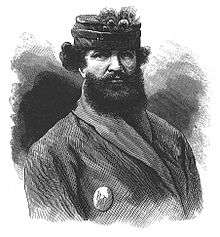Yam (route)
Yam (Mongolian: Өртөө, Örtöö, checkpoint) was a supply point route messenger system extensively used and expanded by Genghis Khan and also used by subsequent Great Khans and Khans.[1]
Relay stations provided food, shelter and spare horses for Mongol army messengers. Genghis Khan gave special attention to Yam because Mongol armies travelled fast, so their messengers had to be even faster, covering 200–300 kilometres (120–190 mi) per day.[1] The system was used to speed up the process of information and intelligence.
The system was preserved in Tsarist Russia after the disintegration of the Golden Horde.
Etymology
The name Yam was adopted in most western languages from Russian, where it probably is a Tatar (Turkic) loan word. The Turkic word root again is related to the Mongolian "Zam" (road or way). However, in the Mongolian Empire, both the postal system and the individual stations were named "Örtöö" ("Örtege" in Classical Mongolian).
Description
The Yam operated with a chain of relay stations at certain distances to each other, usually around 20–40 miles (32–64 km) apart. A messenger would arrive at a station and give his information to another messenger, and meanwhile rest and let the other messenger go on to the next station to hand the document to yet another messenger. This way information or documents were constantly on the move without each messenger getting tired. In each relay station there would be spare horses, food, and shelter.[1]
As one of the most fundamental tools for managing the Mongol Empire, the operation of the Yam system was regulated by the written law Yassa. Both messengers and station operators enjoyed extended privileges. Even for everybody else, the requirements of the Yam took precedence before their other duties and interests, and they had to support it whenever it became necessary. This kind of support was made possible by the strict discipline within the empire, which also led to a high level of security, often described as Pax Mongolica.
At first the system was also available to merchants free of cost. The abuse of this possibility led Möngke Khan to require that commercial users pay for the services.
The service has been described in great detail by European travellers including Giovanni da Pian del Carpine, William of Rubruck, Marco Polo, and Odoric of Pordenone. While it was not the first messenger system in history (earlier ones existed in the Persian and Roman Empires), it was unprecedented in size and efficiency.
Each rider had a paiza.[2] The paiza was an engraved metal pendant, usually circular or rectangular. It symbolized that they were messengers of the Khan.
Tsarist Russia

The system was preserved in Tsarist Russia after the disintegration of the Golden Horde, as a means of fast governmental communication and later also as mail, called yam courier service. It was implemented in the form of yam duty levied onto both urban and rural populations. It was controlled by yamskoy prikaz. The coachman performing yam service was called yamshchik. Many major Russian cities had whole suburbs and villages (slobodas) settled by yamshchiks and called Yamskaya sloboda.
- Gavrilov-Yam, a city in Russia named after the Yam post station network
See also
References
- Weatherford, Jack (2004). Genghis Khan and the Making of the Modern World. New York: Three Rivers Press. ISBN 0-609-80964-4.
- Paiza at www.mongoliacenter.org
Bibliography
- de Hartog, Leo (2004). Genghis Khan: Conqueror of the World. Tauris Parke Paperbacks. pp. 40–41. ISBN 1-86064-972-6.